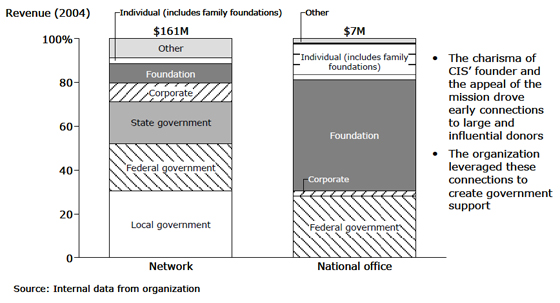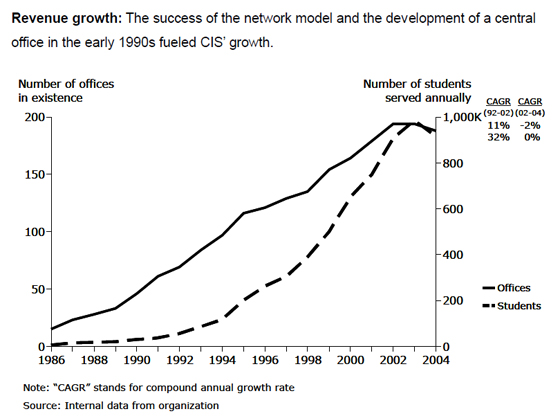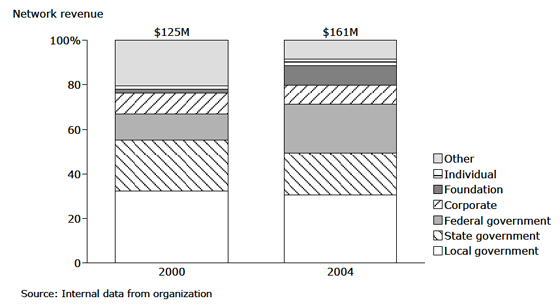The 60’s saw a lot of great movements that died. They were led by great frontier people who couldn’t relate to the settlers. They wanted new ideas but didn’t build organizations. Passion and professionalism keep it in balance.
– Bill Milliken, Co-Chairman
Overview
Related Content
How Nonprofits Get Really BigOrganization Profiles from How Nonprofits Get Really Big
Communities In Schools began in Atlanta in 1971 as EXODUS, a program which helped young people finish high school. In 1973, that effort became the dropout prevention model that was studied, refined, and replicated across the country under the name Cities in Schools, now known as Communities In Schools.
From its beginnings in Atlanta, CIS has grown to become the largest dropout prevention program in the country, reaching nearly 2 million children and families in 28 states. The organization works to insure that every child receives the “five basics”: a personal relationship with a caring adult; a safe place; a healthy start; a marketable skill; and a chance to give back. It has championed the connection of needed community resources with schools. By bringing caring adults into the schools to address children’s unmet needs, CIS provides the link between educators and the community. The result: teachers are free to teach, and students—many in jeopardy of dropping out—have the opportunity to focus on learning.
CIS is now a national network of state offices and local programs. Its network structure allows state offices to seek their own funding, while the national office derives its funding from large donations from individuals and foundations as well as from a federal earmark. Cross-sector boards with business, nonprofit, and school leaders are also critical to CIS.
Founding date: 1977
Revenue (2004): Network - $161 million; state offices - $10 million; national office - $7 million (national office)
Structure: Network
NCCS classification: Education—educational support
Services: Provides social services to at-risk youth in schools
Beneficiaries: High-school age dropouts and below-grade-level students
Leadership (selected): Dan Cardinali, President; Bill Milliken, Founder and Vice Chairman; Susan Siegel, Vice President, Research, Evaluation and Learning Management
Address: 277 South Washington Street, Suite 210 Alexandria, VA 22314
Website: www.communitiesinschools.org

Growth Story
- 1971 – CIS begins in Atlanta as EXODUS, helping young people finish high school.
- 1975 – The governor of Georgia channels state funds to the program.
- 1977 – Federal sources and strong individual support fund the creation of a central office. Bill Milliken, Neil Shorthouse, and David Lewis formally found the organization, which is initially known as Cities in Schools.
- 1981 – CIS loses its federal funding and begins to run significant budget deficits. The organization shifts to a network structure to allow affiliates to pursue funding independently. CIS also develops corporate funding sources and begins to build a strong board for the national office.
- 1984 – CIS’ national office moves to Alexandria, VA.
- Late 1980s - early 1990s – CIS continues to develop national and local business connections. The organization opens state offices to support local affiliates. The national office develops expertise in network support and management.
- 1988 – CIS regains access to federal funding.
- 1993 – The national office secures a federal earmark, spurring network growth.
- 2003 - 2004 – Decreased federal funding creates financial challenges which are exacerbated by the loss of a key individual supporter. The national office once again runs budget deficits, prompting a leadership transition and greater emphasis on financial sustainability.
Revenue Trends
Revenue growth: The success of the network model and the development of a central office in the early 1990s fueled CIS’ growth.

Funding mix: Government funding remains CIS’ dominant funding stream, despite previous setbacks with this source.

Actions That Helped Propel Growth in Funding
- Rode the founders’ commitment and passion. The personal qualities of CIS’ founders and their focus on “love and relationships,” along with their determination and entrepreneurialism, attracted leaders who built the network.
- Measured outcomes. CIS moved early in its existence to measure student outcomes, which increased its appeal to government funders and validated its unorthodox model.
- Transitioned to a network structure to sustain growth. CIS became a network organization in the mid 1980s. Opening affiliates in local markets and giving them autonomy to develop local relationships and secure state and federal contracts, fostered rapid network growth.
- Relayed a strong individual donor base into corporate and government funding. CIS’ founders consistently sought to leverage their networks of individual sponsors to access government and philanthropic funding.
- Secured separate funding for the national office. The national office’s role in managing the network did not attract funding from the same sources as CIS’ direct-service local chapters. Access to a federal earmark was crucial for the growth of the national office.
Funding Challenges
- Surviving the ups and downs of federal funding. Cuts and pull-backs in federal funding have hit the organization hard at various times in its existence, provoking budget deficits.
- Managing a locally-funded network. The locally-funded nature of the CIS network has made it difficult for the national office to maintain programmatic consistency and to implement best practices across the network.

